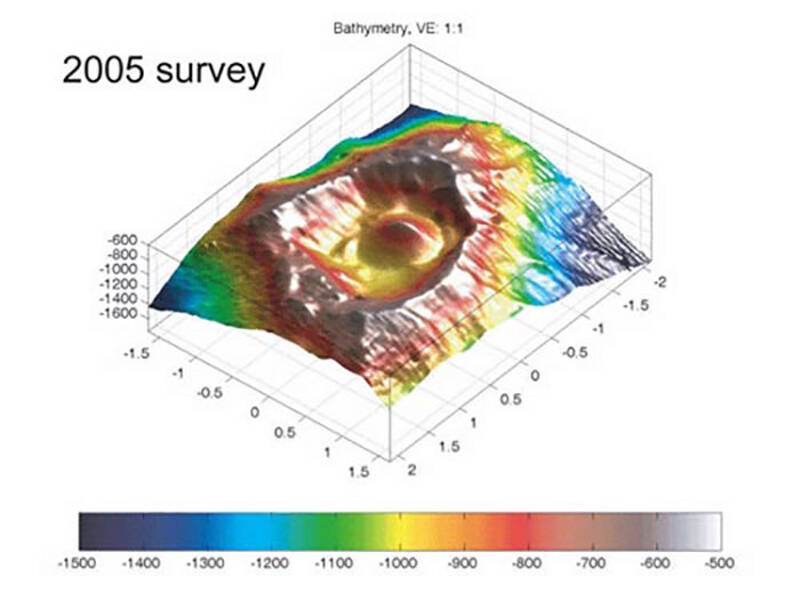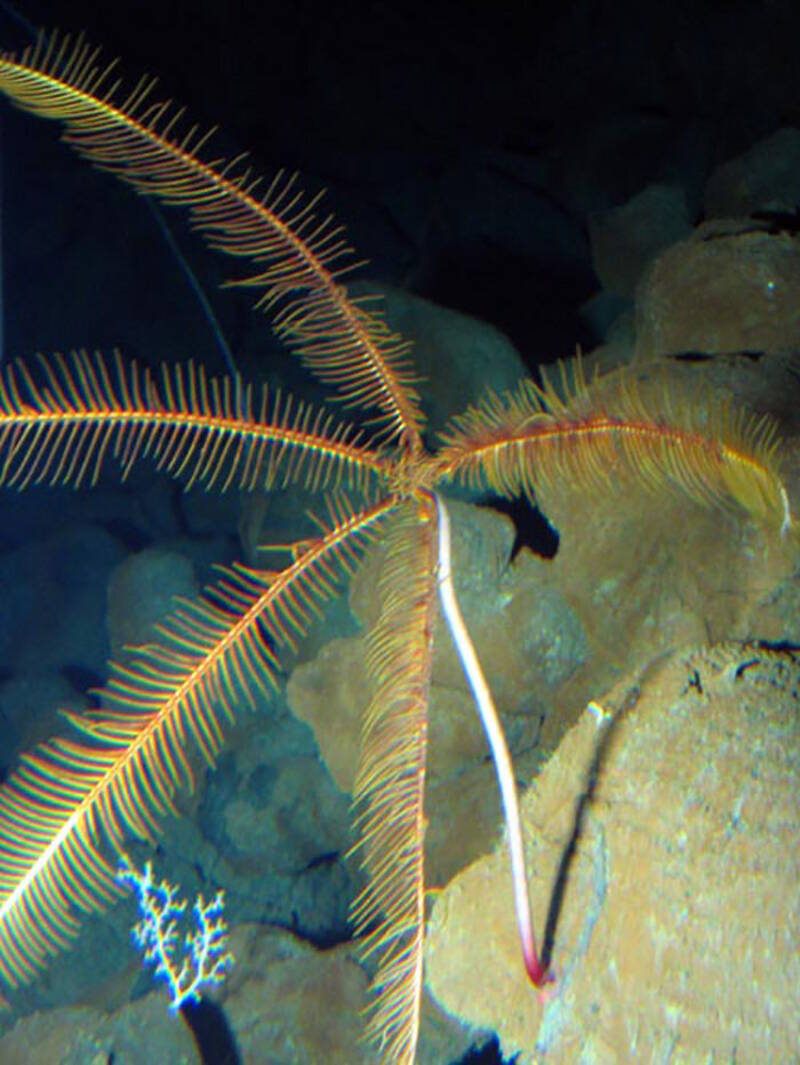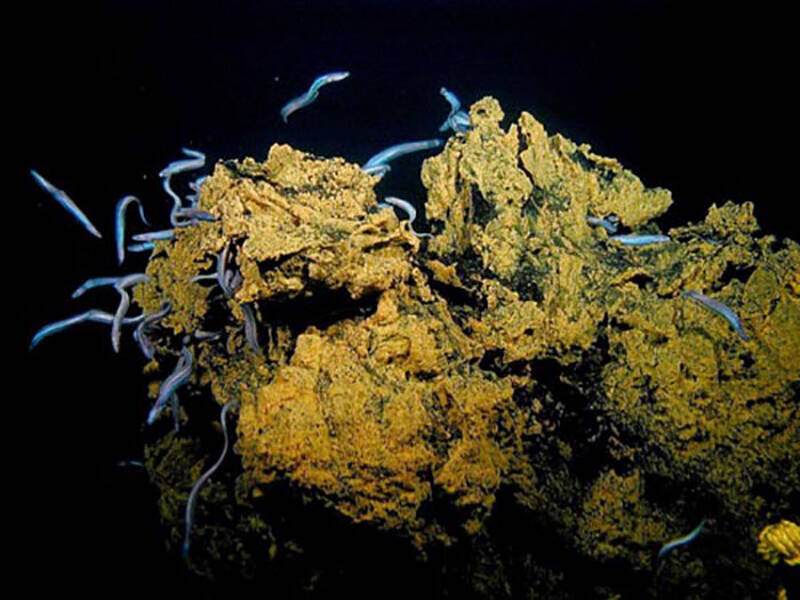
By Mareike Sudek, Research Coordinator, National Marine Sanctuary of American Samoa
Seamounts are formed by volcanic processes that create a mountain on the seafloor. Seamounts can be close to the water surface or thousands of meters deep. Within National Marine Sanctuary of American Samoa are two seamounts: Vailulu’u and Malulu.

Multibeam map from 2005 showing the Vailulu’u seamount crater. The Nafanua cone can be observed in the middle of the crater. Image courtesy of Vailulu'u 2005 Exploration, NOAA-OE. Download image (jpg, 43 KB).
Vailulu’u Seamount is located in between Manu’a and Rose Atoll and is the only hydrothermally active seamount within the American Samoa Exclusive Economic Zone. Discovered in 1975 and first mapped in 1999, Vailulu'u is the active volcanic hotspot that created the Samoan archipelago. It is very large, lying from 600 meters to 5,000 meters in depth. The caldera of Vailulu’u has risen and collapsed repeatedly over time and currently sits at about 1,000 meters below the water's surface. Between 2001 and 2005, new cone formed in the in the middle; the cone was named Nafanua (after the Samoan goddess of war). Researchers have estimated that if activity continues at the current rate, the seamount could breach the surface within decades, forming a new island in the Samoan island chain.
Malulu Seamount is located near Vailulu’u, but much less is known about this seamount. It is very deep, lying from 2,400 meters to 4,800 meters in depth.
Generally, seamounts are highly productive and support a rich biodiversity of organisms. Some species of bottomfish found on seamounts are very important to commercial fisheries, such as snappers (Lutjanidae), groupers (Serranidae), jacks (Carangidae), and emperors (Lethrinidae). Most bottomfish are associated with hard substrates, holes, ledges, or caves and are believed to not migrate between isolated seamounts. While highly migratory species, including bigeye and yellowfin tuna, traverse across the entire south Pacific basin, they are known to be attracted to geological features such as seamounts and islands.

A large stalked crinoid on the outer southwest flank of Vailulu'u Seamount. Image courtesy of Vailulu'u 2005 Exploration, NOAA-OE. Download image (jpg, 108 KB).
Marine mammals, sharks, and cephalopods also gather over seamounts to feed. This is due to the enhanced water flow through localized tides, eddies, and upwelling, which enhance primary production and thus increase available food resources. This creates a fish and invertebrate "hotspot" within the otherwise low-abundance pelagic environment.
Taylor column eddies (eddies that form above seamounts) are believed to retain pelagic larvae, creating a food source as well as increased settlement of larvae. Seamounts provide spawning grounds for many fish; however, it is thought that seamount populations of snappers and groupers may rely on inputs of larvae from external sources.
Each seamount has a unique and diverse ecosystem. Suspension feeders such as cold-water coral, sponges, sea anemones, and sea fans attach to the substrate and form fascinating underwater forests. Sea stars and lobsters crawl along the bottom, large numbers of worms and small crustaceans live in the soft sediment, and a variety of fish species patrol for food.
In National Marine Sanctuary of American Samoa, the Vailulu'u seamount provides habitat to an array of deep-sea organisms, such as sponges, octocoral, crinoids, red polychaete worms, and eels. The crevices on top of Nafanua are occupied by swarms of cutthroat eels (Dysommina rugosa) and so this site was named Eel City. These eels are the only common metazoan (multicellular) animals occupying this low-temperature hydrothermal vent, and preliminary work indicates that they use the vent only as a place to live. They seem to feed not on chemosynthetic bacteria, but on crustaceans that pass by Nafanua's summit in the currents. The area surrounding the base of Nafanua was dubbed the Moat of Death because the waters are turbid and acidic and the bottom is littered with dead fish, squid, and crustaceans. The only animal that appears to thrive there are bright red polychaete worms. Visit this page for more information.

Swarms of cutthroat eels thriving in the crevices on the summit of Nafanua. Scientists dubbed this site "Eel City." Image courtesy of Vailulu'u 2005 Exploration, NOAA-OE. Download image (jpg, 74 KB).
Research has indicated that seamounts play an important role in supporting high biodiversity but the connectivity between seamounts and other adjacent deep-sea ecosystems is poorly understood. Questions relating to the role of seamounts as centers for speciation, refugia, or stepping-stones in trans-oceanic dispersal remain unanswered. Only a few seamounts have been thoroughly investigated. It is therefore not surprising that seamount species diversity, and their biology and life history, remain poorly understood. However, it is thought that some seamount-dwelling species have a very long lifespan (more than 100 years), later sexual maturity, slower growth, and lower natural mortality. For this reason, seamount species, especially those forming aggregations, are very vulnerable to overexploitation. Targeted seamount fisheries can quickly result in population declines. Once depleted, these species require decades or centuries to recover and sometimes even result in the extinction of that species.
The 2017 American Samoa expedition will revisit Vailulu’u Seamount to determine any possible change since the last explorations in 2005 and 2006 and explore Malulu Seamount to shed light on its unique ecosystem. Several completely unknown seamounts to the south and south east of the Monument and Sanctuary's Mulavia Unit will also be mapped and visually explored for the first time.